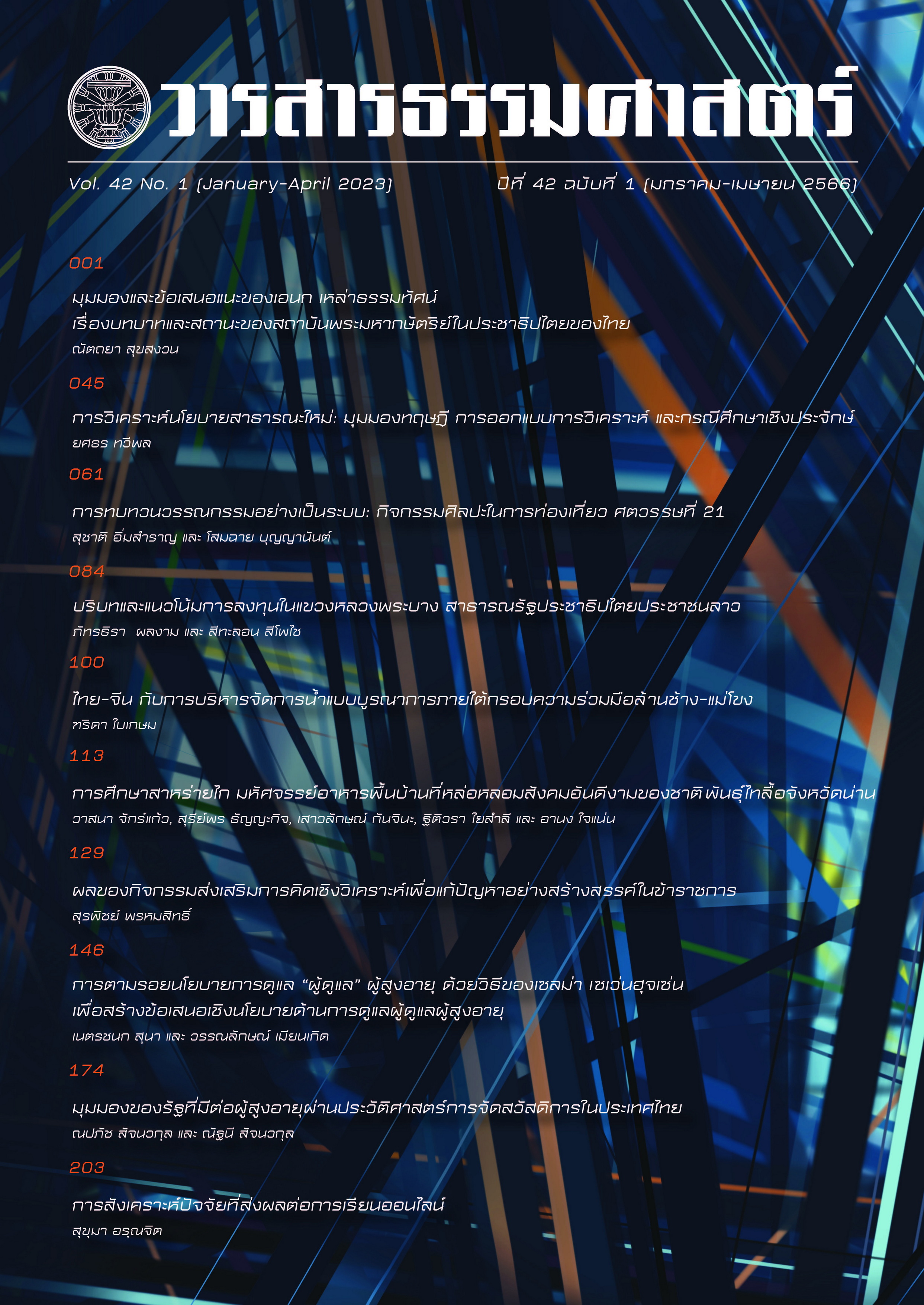The Effect of Enhancing Analytical Thinking on Creative Problem Solving Activities in Government Staffs
Main Article Content
Abstract
The research was a quasi-experimental research design with a pre-test – posttest control group design. The purposes of this study were to compare the result between government staff who were and were not involved in enhancing analytical thinking on creative problem-solving activities; to compare the result of creative thinking before and after being involved in enhancing analytical thinking on creative problem-solving activities. The sample consisted of 97 government staff and was divided into an experimental group of 52 people and a control group of 45 people. The experimental group used creative problem solving consisting of 4 processes: clarify, ideate, develop, and implement. The research instruments included a creative problem-solving process and analytical thinking and a t-test for an independent sample was used to analyze the hypothesis of this study.
The results of the research can be summarized as follows: 1) After the creative problemsolving process, the experimental group showed a significant total analytical thinking scores higher than the control group at .01. 2) The result of the research found that after the creative problem-solving process, the experimental group showed a significant posttest analytical thinking scores higher than the pretest positive thinking score at .05.
Article Details
References
เกรียงศักดิ์ เจริญวงศ์ศักดิ์. (2553). การคิดเชิงวิเคราะห์. พิมพ์ครั้งที่ 6. กรุงเทพฯ : ซัคเซสมีเดีย.
ทิศนา แขมมณี. (2554). ทักษะการคิดวิเคราะห์ สังเคราะห์ สร้างสรรค์ และการคิดอย่างมีวิจารณญาณ การบูรณาการในการจัดการเรียนรู้. วารสารราชบัณฑิตยสถาน, 36(2), 188–204.
บุญใจ ศรีสถิตย์นรากูร. (2555). การพัฒนาและตรวจสอบคุณภาพเครื่องมือวิจัย: คุณสมบัติการวัดเชิงจิตวิทยา. กรุงเทพฯ : โรงพิมพ์แห่งจุฬาลงกรณ์มหาวิทยาลัย.
บุญใจ ศรีสถิตย์นรากูร. (2553). ขนาดอิทธิพล การวิเคราะห์อำนาจ การคำนวณขนาดตัวอย่างที่เหมาะสมโดยใช้โปรแกรม G*Power. กรุงเทพฯ : สำนักพิมพ์จุฬาฯ.
ประพันธ์ศิริ สุเสารัจ. (2556). การพัฒนาการคิด. พิมพ์ครั้งที่ 5 ฉบับปรับปรุงใหม่. กรุงเทพฯ : เทคนิคพริ้นติ้ง.
พจนานุกรมฉบับเฉลิมพระเกียรติ พ.ศ. 2530. (2534). พิมพ์ครั้งที่ 10. กรุงเทพฯ : วัฒนาพานิช.
พิกุล สายดวง. (2559). การพัฒนาทักษะการคิดเชิงวิเคราะห์จากการอ่านบทความทางวิชาการภาษาอังกฤษของนักศึกษามหาวิทยาลัยราชภัฏอุบลราชธานี. วารสารมนุษยศาสตร์และสังคมศาสตร์ มหาวิทยาลัยราชภัฏอุบลราชธานี, 7(2), 215-226.
วรภัทร์ ภู่เจริญ. (2546). การคิดอย่างเป็นระบบและเทคนิคการแก้ปัญหา (Systematic Thinking & Problem Solving Techniques). กรุงเทพฯ : อริยชน.
วัชรี เอกโทชุน. (2544). ทำไมต้องใช้แผนภาพลำดับความคิด Graphic Organizer. ศึกษาศาสตร์ปริทัศน์, 16(1), 45-46.
ศศิมา สุขสว่าง. (2563). กระบวนการแก้ไขปัญหาอย่างสร้างสรรค์ Creative Problem Solving. https://www.sasimasuk.com/17104449/
สิทธิชัย ชมพูพาทย์. (2555). การพัฒนาพฤติกรรมการเรียนการสอนเพื่อการแก้ปัญหาอย่างสร้างสรรค์ของครูและนักเรียนในโรงเรียนส่งเสริมนักเรียนที่มีความสามารถพิเศษทางวิทยาศาสตร์โดยใช้การวิจัยปฏิบัติเชิงวิพากษ์. วารสารวิชาการศรีปทุม ชลบุรี, 8(4), 69-77.
สิริลักษณ์ ตาณพันธุ์ และ วลัย อิศรางกูร ณ อยุธยา. (2560). ผลของการจัดกิจกรรมการเรียนรู้สังคมศึกษาโดยใช้กระบวนการแก้ปัญหาเชิงสร้างสรรค์ที่มีต่อความสามารถในการคิดสร้างสรรค์และการคิดอย่างมีวิจารณญาณของนักเรียนระดับชั้นมัธยมศึกษาปีที่ 3. วารสารอิเล็กทรอนิกส์ทางการศึกษา, 12(3), 313-329.
สุวิทย์ มูลคำ. (2553). กลยุทธ์...การสอนคิดวิเคราะห์. พิมพ์ครั้งที่ 5. กรุงเทพฯ : ห้างหุ้นส่วนจำกัดภาพพิมพ์.
อรรควิช จารึกจารีต. (2557). ผลของการใช้โปรแกรมพัฒนาความสามารถในการคิดวิเคราะห์ของนักศึกษาระดับปริญญาตรี คณะจิตวิทยา มหาวิทยาลัยเกษมบัณฑิต.-ปริญญานิพนธ์ กศ.ม.-(การวิจัยและพัฒนาศักยภาพมนุษย์-แขนงวิชาจิตวิทยาการศึกษา).-กรุงเทพฯ : บัณฑิตวิทยาลัย-มหาวิทยาลัยศรีนครินทรวิโรฒ.-
Art-in, S. (2017). Development of Analytical Thinking Skills Among Thai University Students. The Turkish Online Journal of Educational, Special Issue for INTE, 862-869.
Bloom. (1956). Bloom’s taxonomy: Critical Thinking Skills. https://cft.vanderbilt. edu/guides-sub-pages/blooms-taxonomy/
Buchner, A., Faul, F., & Erdfelder, E. (2007). G*Power 3: A flexible statistical power analysis program for the social, behavioral, and biomedical sciences. Behavior Research Methods, 39(2), 175-191. https://link.springer.com/ content/pdf/10.3758/BF03193146.pdf
Campbell, D. T., & Stanley, J. C. (1963). Experimental and Quasi-experimental Designs for Research on Teaching. Chicago: Rand McNally & Company.
Dewey, J. (1933). How We Think: A Restatement of the Relation of Reflective Thinking to the Educative Process. Boston, MA: D.C. Heath & Co Publishers.
Gülen, S. (2019). Development of Critical Thinking Skill Scale for Science Lesson. European Journal of Education Studies, 6(4), 161-179.
Halpern, D. F. (1998). Teaching critical thinking. Teaching of Psychology, 22(1), 75-81.
Hare, W. (2020). Bertrand Russell on Critical Thinking. https://www.bu.edu/wcp/ Papers/Educ/EducHare.htm
Marzano, R. J. (2001). Designing a New Taxonomy of Education Objective. California: Corwin Press, Inc.
Montaku, S. (2011). Results of Analytic Thinking Skills Training through Students in System Analysis and Design course. Proceedings of the IETEC’11 Conference. Kuala Lumpur: Malaysia
Willingham, D. T. (2007). Critical thinking: Why is it so hard to teach? American Educator, 31, 8-19.
Yackal, E., Cobb, P., Wood, T., Markel, G., & Battisla M.T. (1990). Experience, Problem Solving and Discourse and Central Aspects of Constructivism. The Arithmetic Teacher, 38(4), 34-35.

